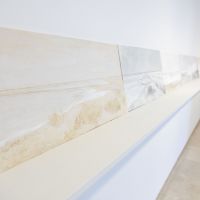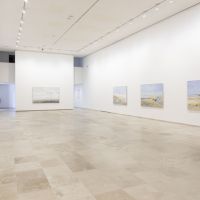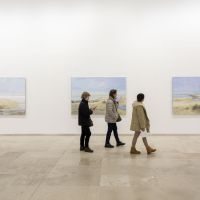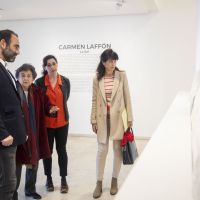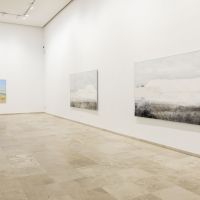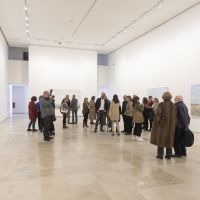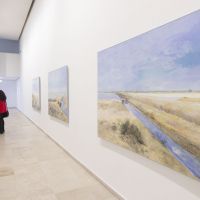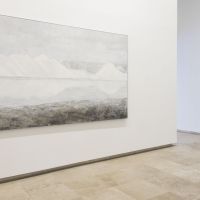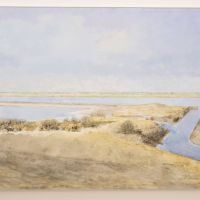CARMEN LAFFĂ“N
La sal

[English version below]
Concebida y realizada junto al Centro Andaluz de Arte ContemporĂ¡neo de Sevilla, la exposiciĂ³n La sal de Carmen LaffĂ³n (Sevilla, 1934) reĂºne una docena de obras de gran formato realizadas por la artista en fechas recientes. LaffĂ³n, una de las pintoras mĂ¡s importantes activas desde la segunda mitad del siglo pasado, vuelve a demostrar un interĂ©s por la observaciĂ³n del lugar, un ejercicio en el que la voluntad de narrar no estĂ¡ exenta de un fuerte contenido emocional. Esta ha sido la tĂ³nica desde aquellos sobresalientes dibujos y pinturas realizados en la Isla de la Cartuja a finales de los años sesenta, en los que se revelaba ya un talante eminentemente moderno, polĂtico incluso, en su asertivo compromiso con lo real. Las obras reunidas en esta exposiciĂ³n ofrecen una mirada igualmente atenta a las salinas de SanlĂºcar de Barrameda, CĂ¡diz, de ahĂ su tĂtulo. La zona de la desembocadura del Guadalquivir, entre CĂ¡diz y Huelva, y con el Coto de Doñana como motivo y testigo privilegiado del hecho pictĂ³rico, es el lugar desde el que la artista sevillana viene desplegando su pintura mĂ¡s suelta y libre. TambiĂ©n la mĂ¡s ambiciosa, pues los formatos que aquĂ aborda son inusitadamente grandes. Las pinturas en concentrados tonos grises y aquellas otras de encendidos tonos azules revelan un interĂ©s por el trabajo en serie y se centran en el estudio detenido de unos lugares, las salinas, que tal vez no sean el motivo mĂ¡s habitual en la tradiciĂ³n de la pintura de paisaje, y es ahĂ donde reside su modernidad. PodrĂ¡n tal vez pertenecer mĂ¡s al Ă¡mbito de la fotografĂa, pero la importancia de la factura y de la materia la alejan del carĂ¡cter objetivo de la prĂ¡ctica fotogrĂ¡fica.
Toda obra de Carmen LaffĂ³n requiere una mirada lenta, y, como delata su obra Ăºltima, tan generosa en sus formatos, un trĂ¡nsito lento tambiĂ©n. Son obras que no se asimilan de un solo vistazo. Hay que recorrerlas, pues son espacios de una amplitud desconocida y en los que el elenco de matices es extraordinario. Tienen, en apariencia, una paleta mĂ¡s reducida, pero la mirada pausada que exigen permite comprobar una riqueza cromĂ¡tica tan asombrosa como la trama de texturas en la que se enreda la pintura. Porque el espacio pictĂ³rico estĂ¡ gobernado por grandes montĂculos de sal, protagonistas de la serie, pero hay en estas pinturas una tensiĂ³n entre imagen y materia que provoca en ocasiones que aquella se plegue a Ă©sta. Las salinas de Carmen LaffĂ³n se encuentran en el espacio que media entre el primer plano y el fondo, entre lo terroso y lo etĂ©reo. Las montañas de sal tienen una presencia rotunda pero no eluden cierto aspecto evanescente, como espectral.
Junto a las salinas vemos otro grupo de pinturas radicalmente diferente en su tratamiento del color, pinturas que comparten la misma intensidad lumĂnica y una composiciĂ³n articulada en torno a una fĂ©rrea lĂnea del horizonte. En la pintura Ăºltima de Carmen LaffĂ³n el horizonte ha jugado un rol esencial. No hay como sentarse frente a la desembocadura del Guadalquivir, con el Coto de Doñana de frente, para percibir el fortĂsimo eje horizontal que preside la escena. Si ya en las imĂ¡genes del Coto, realizadas durante casi una dĂ©cada entre los años 2005 y 2014, el horizonte era el protagonista en cuadros de un mismo formato caracterizados por un tratamiento melancĂ³lico de la imagen, estos cuadros Ăºltimos ahondan en la singularidad geogrĂ¡fica del paisaje, modelado por siglos de avatares histĂ³ricos que han condicionado la realidad fĂsica, econĂ³mica y social de la zona. Entronca asĂ LaffĂ³n con aquellas primeras obras de los sesenta en torno a las transformaciones de la Isla sevillana de La Cartuja, y revitaliza asĂ una relaciĂ³n con el paisaje que, siempre desde un quehacer infatigable, trasciende las convenciones del gĂ©nero.
La muestra presenta tambiĂ©n un importante conjunto de bajorrelieves en torno al mismo motivo realizados en fechas recientes que revelan de nuevo un interĂ©s por la lĂnea del horizonte, un elemento inseparable de la experiencia contemplativa de toda una vida.
Carmen LaffĂ³n. La sal (Salt)
Conceived and produced in conjunction with the Andalusian Centre for Contemporary Art in Seville, the exhibition La sal (Salt) by Carmen LaffĂ³n (Seville, 1934) brings together a dozen large-format pieces recently produced by the artist. LaffĂ³n, one of the most significant painters from the second half of the twentieth century who is still active, once again shows an interest in observing the place, an exercise in which the desire to narrate does not exclude powerful emotional content. This has been the tone since those outstanding drawings and paintings produced on the Isla de la Cartuja in the late 1960s, in which an eminently modern, even political, mood was revealed in her assertive commitment to the real. The pieces brought together in this exhibition provide us with an equally attentive look at the salt flats of SanlĂºcar de Barrameda, CĂ¡diz; hence the title. The area at the mouth of the River Guadalquivir, between Cadiz and Huelva, and with the Doñana Nature Reserve as a motif and privileged witness of the picture, is the place from which the artist has displayed her loosest and freest painting. It is also the most ambitious, as the formats she employs here are unusually large. The paintings in concentrated shades of grey and those in fiery blue reveal an interest in serial work and focus on the careful study of certain places – the salt flats which are perhaps not the most common motif in the tradition of landscape painting. This is where her modernity lies. The paintings may perhaps belong more to the field of photography, but the importance of the workmanship and the material distances them from the objective nature of photography.
All of Carmen LaffĂ³n’s work requires detailed observation, and, as her latest work, so generous in its formats, reveals, you can’t just walk past it. Her works of art cannot be assimilated at a single glance. You have to travel through them, because they are spaces of an unknown amplitude, in which the range of shades is extraordinary. She apparently uses a more limited palette, but the detailed observance the paintings demand enables us to see a chromatic wealth as amazing as the weft of textures in which the painting is entangled. The pictorial space is governed by large mounds of salt, the protagonists of the series, but there is a tension between image and matter in these paintings that sometimes causes the former to blend into the latter. Carmen LaffĂ³n’s salt mounds are found in the space between the foreground and the background, between the earthy and the ethereal. The mountains of salt have a resounding presence but cannot elude a certain evanescent aspect, as if they were something spectral.
Next to the salt pans we see another group of paintings that are radically different in their treatment of colour, paintings that share the same luminous intensity and a composition that revolves around the iron-clad line of the horizon. In Carmen LaffĂ³n’s latest painting the horizon plays an essential role. There is nothing like sitting in front of the mouth of the River Guadalquivir, facing the Doñana Nature Reserve, to perceive the powerful horizontal axis that presides over the scene. If in the images of the Nature Reserve, produced over almost a decade from 2005 to 2014, the horizon was already the main player in pictures of the same format characterized by a melancholic treatment of the image, these latter pictures delve into the geographical uniqueness of the landscape, modelled by centuries of historical vicissitudes that have conditioned the physical, economic and social situation of the area. LaffĂ³n thus links up to those early works from the 1960s that dealt with the transformations of the Island of La Cartuja in Seville, and thus revitalizes her relationship with the landscape, which from untiring activity transcends the conventions of the genre.
The exhibition also includes a major series of bas-reliefs dealing with the same motif, produced more recently, and which once again reveal an interest in the line of the horizon, an inseparable element of the contemplative experience of a whole life.

